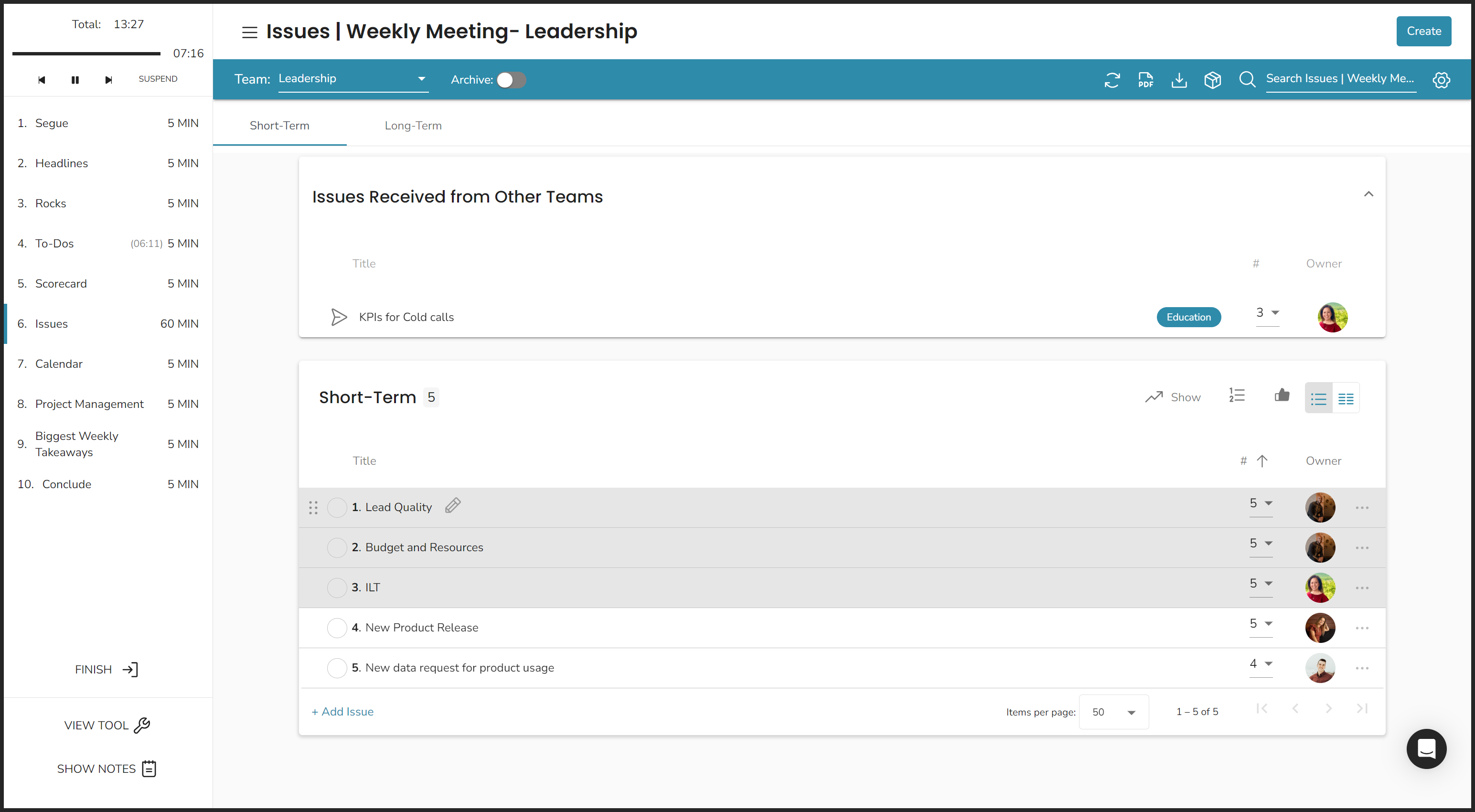Introduction to Meetings
How Ninety's Meeting tool improves accountability, productivity, and engagement for teams.
-
 Insights
Insights
-
 Data
Data
-
 Rocks
Rocks
-
 To-Dos
To-Dos
-
 Issues
Issues
-
 Meetings
Meetings
-
 Headlines
Headlines
-
 Vision
Vision
-
 Org Chart
Org Chart
-
 1-on-1
1-on-1
-
 Directory
Directory
-
 Knowledge Portal
Knowledge Portal
-
 Assessments
Assessments
-
 Integrations
Integrations
-
 Account Options and Troubleshooting
Account Options and Troubleshooting
-
Mobile
-
 Partner Hub
Partner Hub
Table of Contents
What Is the Meetings Tool?
Use the Meetings tool![]() to manage your daily, weekly, monthly, quarterly, and annual meetings. We've pre-populated proven agendas to ensure your meetings are efficient, effective, and documented. Team leaders can also customize or create their own agendas to tailor meetings to specific needs.
to manage your daily, weekly, monthly, quarterly, and annual meetings. We've pre-populated proven agendas to ensure your meetings are efficient, effective, and documented. Team leaders can also customize or create their own agendas to tailor meetings to specific needs.
Ninety simplifies meeting management with the following:
- Segment and total timers
- Integration with Ninety's tools
- Issue-solving performance metrics
- Automatic recap emails
- Built-in notes capability
- Mobile-friendly interface
- And more
You can learn how to get started with the Meetings tool from the video below.
Access to the Meetings Tool
The features available on the Meetings tool vary based on your company's subscription model. Here's a basic breakdown:
- Thrive: All features, including AI assistance for meeting preparation.
- Accelerate: Most features, including creating agendas, quarterly/annual meetings, and more.
- Essentials: Access our default weekly meeting agendas to run each of your team's weekly meetings.
How Improving Meetings Supports Your Organization's Goals
Our Meetings tool brings additional accountability and productivity to your organization. We've designed it to optimize your team's weekly meetings and made it scalable for any meeting you need to run.
People are far more engaged in meetings when they know what's expected of them and what they'll be accountable for once the meeting ends… At a basic level, we bring people together for five reasons:
- To get information or opinions.
- To give information or opinions.
- To solve Issues (by making decisions and committing to actions).
- To create and work on ideas.
- To maintain or increase trust.
From our blog, More Than Just Talk: The Purpose and Benefits of Meetings
How Meetings Supports Ninety's Other Tools
Ninety's tools integrate directly with the Meetings tool, so your team can quickly review their Scorecards, To-Dos, Issues, and more. Click through the tabs below to learn more about how the Meetings tool supports other core tools.
Data
Our Data tool brings all your team's Scorecards to your meetings. Cycle through weekly, trailing, monthly, quarterly, and annual Scorecards as needed to get a pulse on team and organizational health.

Rocks
Reviewing Rocks as a team gives everyone a chance to report on their progress, share impediments, and raise any Issues for further discussion. During quarterly and annual meetings, teams will discuss long-term Issues or new ideas for Rocks. In general, Rocks are quarterly goals outside the scope of daily work. Rocks can involve new projects, fixing something, or a portion of a larger initiative, like an annual goal.

To-Dos
Reviewing your team's To-Dos in a meeting promotes accountability and transparency. Typically, teams will only need to review any past-due items and check for impediments for anything due in the next seven days.

Issues
Raising, discussing, and resolving Issues is one of the primary reasons for bringing team members away from their work and into meetings. Ninety's Issues tool creates two Issues lists for every team in your organization.
- Short Term Issues List — problems, obstacles, ideas, or opportunities to discuss and solve each week to keep teams moving forward.
- Long Term Issues List — Issues that don't have priority this quarter, but should be discussed in the future (usually during a quarterly or annual meeting).
Each list has it's own page in the Issues tool. You can move Issues between each list be right-clicking the item and selecting the opposite list from the dropdown.

Headlines
Headlines are announcements that usually don’t warrant a discussion or need additional action items. Any licensed user can send Headlines to other teams as a Cascading Message.
Since Headlines and Cascading Messages are reviewed as a team, they offer accountability and assurance that everyone understands the information presented.

1-on-1
Our 1-on-1 feedback tool is designed to transform performance reviews into a chance for a team leader and direct report to have a conversation around the latter's roles, accountabilities, responsibilities, and more associated with their Seat.
This tool utilizes forms for each party to fill out before the conversation begins and has its own meeting portal to conduct and archive the discussion.

Helpful Resources
To learn more about our teachings holding great meetings, check out the following:
- Best practices for solving Issues in meetings
- Weekly team meetings brief and guide
- Annual planning meetings brief and guide
- Quarterly planning meetings brief and guide
- Foundation setting session
- Vision and goal setting sessions
- State of the company meetings